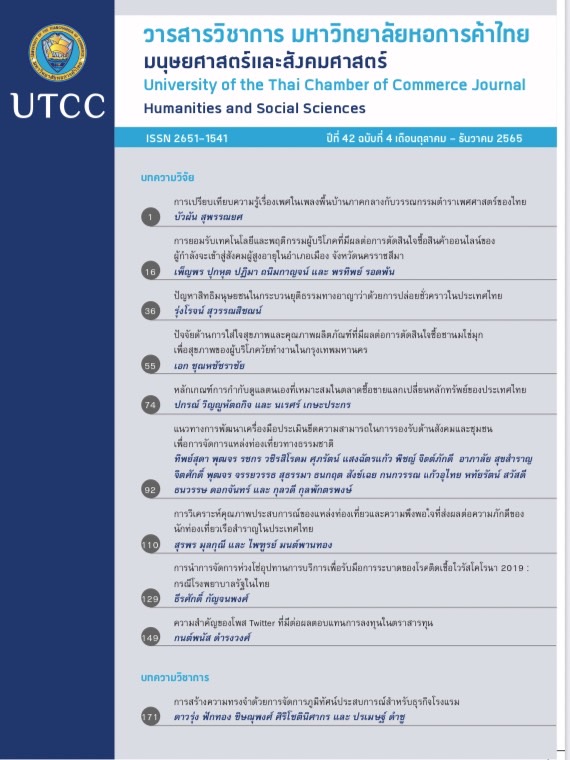The Predictive Power of Twitter Sentiment Index on U.S. Stock Returns
Main Article Content
Abstract
Using a novel Twitter-based investor sentiment index, this research investigates whether investor sentiment from social media, as expressed in daily Twitter messages, has predictive power with respect to stock returns. Based on hierarchical regressions, the empirical results show that the Twitter sentiment index has additional predictive power for U.S. stock returns, which is not captured by traditional factors, such as market risk premium, firm size, book-to-market ratio, or momentum. The results suggest that investor sentiments from social media significantly affect short-term equity value. Thus, individual investors and fund managers should be aware of the impact social media sentiment can have on both their own portfolios and fund managers’ investment strategies.
Article Details

This work is licensed under a Creative Commons Attribution-NonCommercial-NoDerivatives 4.0 International License.
ลิขสิทธิ์ของบทความ
ผลงานที่ได้รับการตีพิมพ์ถือเป็นลิขสิทธิ์ของมหาวิทยาลัยหอการค้าไทย ห้ามมิให้นำเนื้อหา ทัศนะ หรือข้อคิดเห็นใด ๆ ของผลงานไปทำซ้ำ ดัดแปลง หรือเผยแพร่ ไม่ว่าทั้งหมดหรือบางส่วนโดยไม่ได้รับอนุญาตเป็นลายลักษณ์อักษรจากมหาวิทยาลัยหอการค้าไทยก่อน
References
Baker, M., & Stein, J. C. (2004). Market liquidity as a sentiment indicator. Journal of Financial Markets, 7(3), 271-299. doi: 10.1016/j.finmar.2003.11.005
Baker, M., & Wurgler, J. (2006). Investor sentiment and the cross-section of stock returns. Journal of Finance, 61(4), 1645-1680. doi: 10.1111/j.1540-6261.2006.00885.x
Baker, M., & Wurgler, J. (2007). Investor sentiment in the stock market. Journal of Economic Perspectives, 21(2), 129-152.
Baker, M., Wurgler, J., & Yuan, Y. (2012). Global, local, and contagious investor sentiment. Journal of Financial Economics, 104(2), 272-287. doi: 10.1016/j.jfineco.2011.11.002
Black, F. (1986). Noise. Journal of Finance, 41(3), 529-543.
Carhart, M. (1997). On persistence in mutual fund performance. Journal of Finance, 52(1), 57-82.
Da, Z., Engelberg, J., & Gao, P. (2015). The sum of all FEARS investor sentiment and asset prices. Review of Financial Studies, 28(1), 1-32. doi: 10.1093/rfs/hhu072
Daniel, K., Hirshleifer, D., & Subrahmanyam, A. (1998). Investor psychology and security market under- and overreactions. Journal of Finance, 53(6), 1839-1885
De Long, J. B., Shleifer, A., Summers, L. H., & Waldmann, R. J. (1990). Noise trader risk in financial markets. Journal of Political Economy, 98(4), 703-738.
Dergiades, T. (2012). Do investors’ sentiment dynamics affect stock returns? Evidence from the US economy. Economic Letters, 116(3), 404-407. doi: 10.1016/j.econlet.2012.04.018
Dickey, D. A., & Fuller, W. A. (1979). Distribution of the estimators for autoregressive time series with a unit root. Journal of the American Statistical Association, 74(366), 427-431.
Ding, W., Mazouz, K., & Wang, Q. (2019). Investor sentiment and the cross-section of stock returns: New theory and evidence. Review of Quantitative Finance and Accounting, 53(2), 493-525.
Dodds, P. S., Harris, K. D., Kloumann, I. M., Bliss, C. A., & Danforth, C. M. (2011). Temporal patterns of happiness and information in a global social network: Hedonometrics and Twitter. PLoS One, 6(12), e26752. doi: 10.1371/journal.pone.0026752
Fama, E. F., & French, K. R. (1993). Common risk factors in the returns on stocks and bonds. Journal of Financial Economics, 33(1), 3-56. doi: 10.1016/0304-405X(93)90023-5
Fama, E. F., & French, K. R. (2015). A five-factor asset pricing model. Journal of Financial Economics, 116(1), 1-22. doi: 10.1016/j.jfineco.2014.10.010
Fama, E. F., & French, K. R. (2020). Comparing cross-section and time-series factor models. Review of Financial Studies, 33(5), 1891-1926. doi: 10.1093/rfs/hhz089
French, K. R. (2021). French data library. Retrieved January 20, 2021, from https://mba.tuck.
dartmouth.edu/pages/faculty/ken.french/data_library.html
Gibbons, M. R., Ross, S., & Shanken, J. (1989). A test of the efficiency of a given portfolio.Econometrica, 57(5), 1121-52.
Kaplanski, G., Levy, H., Veld, C., & Veld-Merkoulova, Y. (2015). Do happy people make optimistic investors? Journal of Financial and Quantitative Analysis, 50(1/2), 145-168
Kemp, S. (2020). Global report 2020. Retrieved February 3, 2021, from https://www.hootsuite.com/pages/digital-2020
Kim S., & Kim, D. (2014). Investor sentiment from internet message postings and the predictability of stock returns. Journal of Economic Behavior & Organization, 107(Pt. B), 708-729. doi: 10.1016/j.jebo.2014.04.015
Lee, C. M. C., Shleifer, A., & Thaler, R. H. (1991). Investor sentiment and the closed-end fundpuzzle. Journal of Finance, 46(1), 75-109.
Lemmon, M., & Portniaguina, E. (2006). Consumer confidence and asset prices: Some empirical evidence. Review of Financial Studies, 19(4), 1499-1529.
Naeem, M. A., Farid, S., Balli, F., & Shahzad, S. J. H. (2020). Can happiness predict future volatility instock markets? Research in International Business and Finance, 54, 101298.doi:10.1016/j. ribaf.2020.101298
Phillips, P. C. B., & Perron, P. (1988). Testing for a unit root in time series regression. Biometrika,75(2), 335-346.
Shleifer, A., & Summers, L. H. (1990). The noise trader approach to finance. Journal of Economic Perspectives, 4(2), 19-33.
Shleifer, A., & Vishny, R. W. (1997). The limits of arbitrage. Journal of Finance, 52(1), 35-55.
Siganos, A., Vagenas-Nanos, E., & Verwijmeren, P. (2014). Facebook’s daily sentiment and international stock markets. Journal of Economic Behavior & Organization, 107(Pt. B), 730-743. doi: 10.1016/j.jebo.2014.06.004
Zhang, W., Li,X., Shen, D., & Teglio, A. (2016). Dailyhappiness andstock returns: Some international evidence. Physica A: Statistical Mechanics and its Applications, 460,201-209.doi:10.1016/j. physa.2016.05.026
Zhang, W., Wang, P., Li, X., & Shen, D. (2018). Twitter’s daily happiness sentiment and international stock returns: Evidence from linear and nonlinear causality tests. Journal of Behavioral and Experimental Finance, 18, 50-53. doi: 10.1016/j.jbef.2018.01.005
Zhao, R. (2020). Quantifying the cross sectional relation of daily happiness sentiment and stock return: Evidence from US. Physica A: Statistical Mechanics and its Applications, 538, 122629. doi: 10.1016/j.physa.2019.122629


